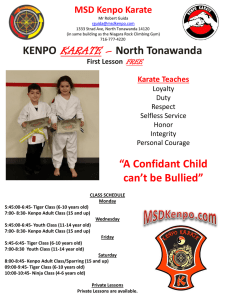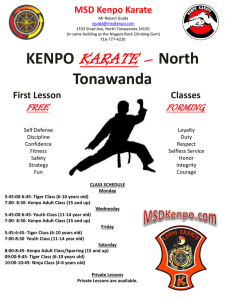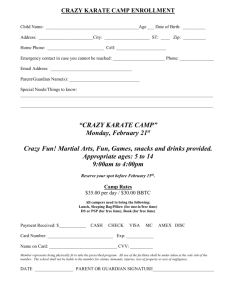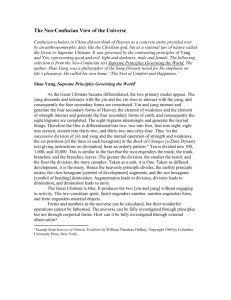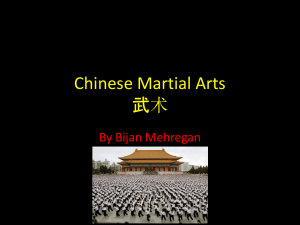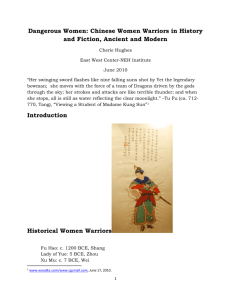HISTORY AND PHILOSOPHY OF
advertisement
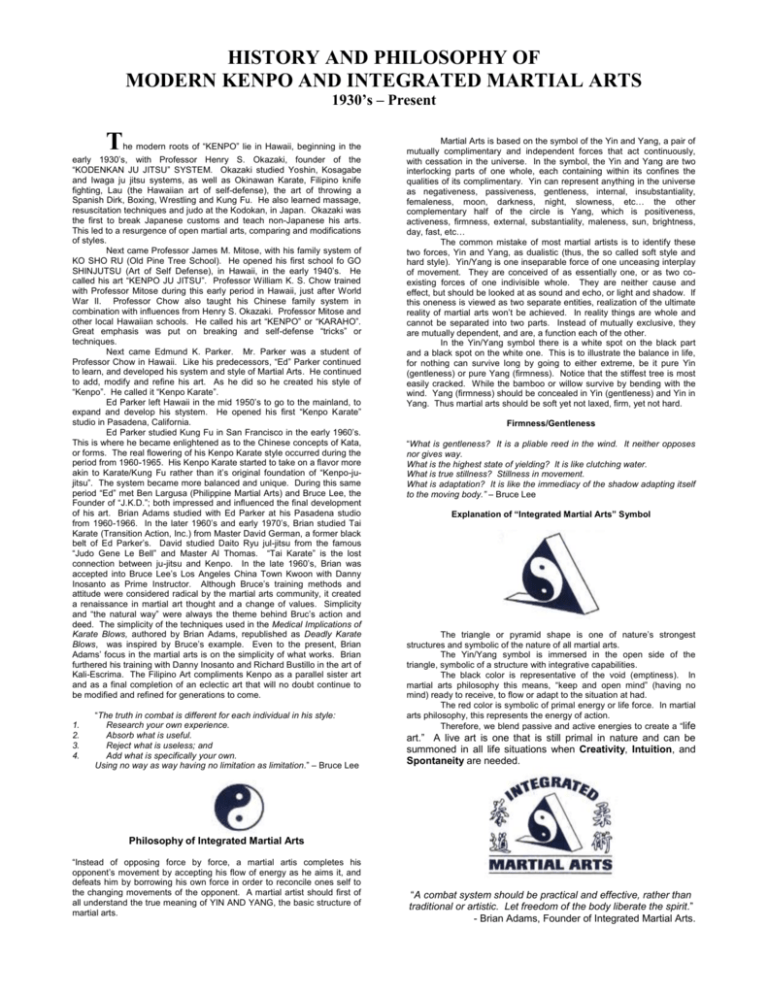
HISTORY AND PHILOSOPHY OF MODERN KENPO AND INTEGRATED MARTIAL ARTS 1930’s – Present T he modern roots of “KENPO” lie in Hawaii, beginning in the early 1930’s, with Professor Henry S. Okazaki, founder of the “KODENKAN JU JITSU” SYSTEM. Okazaki studied Yoshin, Kosagabe and Iwaga ju jitsu systems, as well as Okinawan Karate, Filipino knife fighting, Lau (the Hawaiian art of self-defense), the art of throwing a Spanish Dirk, Boxing, Wrestling and Kung Fu. He also learned massage, resuscitation techniques and judo at the Kodokan, in Japan. Okazaki was the first to break Japanese customs and teach non-Japanese his arts. This led to a resurgence of open martial arts, comparing and modifications of styles. Next came Professor James M. Mitose, with his family system of KO SHO RU (Old Pine Tree School). He opened his first school fo GO SHINJUTSU (Art of Self Defense), in Hawaii, in the early 1940’s. He called his art “KENPO JU JITSU”. Professor William K. S. Chow trained with Professor Mitose during this early period in Hawaii, just after World War II. Professor Chow also taught his Chinese family system in combination with influences from Henry S. Okazaki. Professor Mitose and other local Hawaiian schools. He called his art “KENPO” or “KARAHO”. Great emphasis was put on breaking and self-defense “tricks” or techniques. Next came Edmund K. Parker. Mr. Parker was a student of Professor Chow in Hawaii. Like his predecessors, “Ed” Parker continued to learn, and developed his system and style of Martial Arts. He continued to add, modify and refine his art. As he did so he created his style of “Kenpo”. He called it “Kenpo Karate”. Ed Parker left Hawaii in the mid 1950’s to go to the mainland, to expand and develop his stystem. He opened his first “Kenpo Karate” studio in Pasadena, California. Ed Parker studied Kung Fu in San Francisco in the early 1960’s. This is where he became enlightened as to the Chinese concepts of Kata, or forms. The real flowering of his Kenpo Karate style occurred during the period from 1960-1965. His Kenpo Karate started to take on a flavor more akin to Karate/Kung Fu rather than it’s original foundation of “Kenpo-jujitsu”. The system became more balanced and unique. During this same period “Ed” met Ben Largusa (Philippine Martial Arts) and Bruce Lee, the Founder of “J.K.D.”; both impressed and influenced the final development of his art. Brian Adams studied with Ed Parker at his Pasadena studio from 1960-1966. In the later 1960’s and early 1970’s, Brian studied Tai Karate (Transition Action, Inc.) from Master David German, a former black belt of Ed Parker’s. David studied Daito Ryu jul-jitsu from the famous “Judo Gene Le Bell” and Master Al Thomas. “Tai Karate” is the lost connection between ju-jitsu and Kenpo. In the late 1960’s, Brian was accepted into Bruce Lee’s Los Angeles China Town Kwoon with Danny Inosanto as Prime Instructor. Although Bruce’s training methods and attitude were considered radical by the martial arts community, it created a renaissance in martial art thought and a change of values. Simplicity and “the natural way” were always the theme behind Bruc’s action and deed. The simplicity of the techniques used in the Medical Implications of Karate Blows, authored by Brian Adams, republished as Deadly Karate Blows, was inspired by Bruce’s example. Even to the present, Brian Adams’ focus in the martial arts is on the simplicity of what works. Brian furthered his training with Danny Inosanto and Richard Bustillo in the art of Kali-Escrima. The Filipino Art compliments Kenpo as a parallel sister art and as a final completion of an eclectic art that will no doubt continue to be modified and refined for generations to come. 1. 2. 3. 4. “The truth in combat is different for each individual in his style: Research your own experience. Absorb what is useful. Reject what is useless; and Add what is specifically your own. Using no way as way having no limitation as limitation.” – Bruce Lee Martial Arts is based on the symbol of the Yin and Yang, a pair of mutually complimentary and independent forces that act continuously, with cessation in the universe. In the symbol, the Yin and Yang are two interlocking parts of one whole, each containing within its confines the qualities of its complimentary. Yin can represent anything in the universe as negativeness, passiveness, gentleness, internal, insubstantiality, femaleness, moon, darkness, night, slowness, etc… the other complementary half of the circle is Yang, which is positiveness, activeness, firmness, external, substantiality, maleness, sun, brightness, day, fast, etc… The common mistake of most martial artists is to identify these two forces, Yin and Yang, as dualistic (thus, the so called soft style and hard style). Yin/Yang is one inseparable force of one unceasing interplay of movement. They are conceived of as essentially one, or as two coexisting forces of one indivisible whole. They are neither cause and effect, but should be looked at as sound and echo, or light and shadow. If this oneness is viewed as two separate entities, realization of the ultimate reality of martial arts won’t be achieved. In reality things are whole and cannot be separated into two parts. Instead of mutually exclusive, they are mutually dependent, and are, a function each of the other. In the Yin/Yang symbol there is a white spot on the black part and a black spot on the white one. This is to illustrate the balance in life, for nothing can survive long by going to either extreme, be it pure Yin (gentleness) or pure Yang (firmness). Notice that the stiffest tree is most easily cracked. While the bamboo or willow survive by bending with the wind. Yang (firmness) should be concealed in Yin (gentleness) and Yin in Yang. Thus martial arts should be soft yet not laxed, firm, yet not hard. Firmness/Gentleness “What is gentleness? It is a pliable reed in the wind. It neither opposes nor gives way. What is the highest state of yielding? It is like clutching water. What is true stillness? Stillness in movement. What is adaptation? It is like the immediacy of the shadow adapting itself to the moving body.” – Bruce Lee Explanation of “Integrated Martial Arts” Symbol The triangle or pyramid shape is one of nature’s strongest structures and symbolic of the nature of all martial arts. The Yin/Yang symbol is immersed in the open side of the triangle, symbolic of a structure with integrative capabilities. The black color is representative of the void (emptiness). In martial arts philosophy this means, “keep and open mind” (having no mind) ready to receive, to flow or adapt to the situation at had. The red color is symbolic of primal energy or life force. In martial arts philosophy, this represents the energy of action. Therefore, we blend passive and active energies to create a “life art.” A live art is one that is still primal in nature and can be summoned in all life situations when Creativity, Intuition, and Spontaneity are needed. Philosophy of Integrated Martial Arts “Instead of opposing force by force, a martial artis completes his opponent’s movement by accepting his flow of energy as he aims it, and defeats him by borrowing his own force in order to reconcile ones self to the changing movements of the opponent. A martial artist should first of all understand the true meaning of YIN AND YANG, the basic structure of martial arts. “A combat system should be practical and effective, rather than traditional or artistic. Let freedom of the body liberate the spirit.” - Brian Adams, Founder of Integrated Martial Arts.
